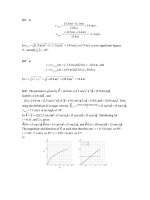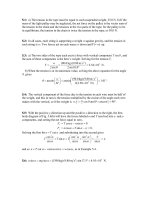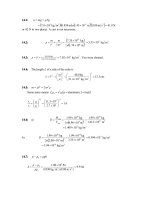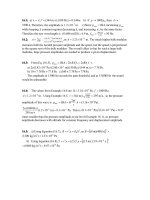Tài liệu Physics exercises_solution: Chapter 03 doc
Bạn đang xem bản rút gọn của tài liệu. Xem và tải ngay bản đầy đủ của tài liệu tại đây (539.16 KB, 41 trang )
3.1: a)
,sm4.1
)s0.3(
)m1.1()m3.5(
ave,
x
v
.sm3.1
)s0.3(
)m4.3()m5.0(
ave,
y
v
b)
sm9.1or ,sm91.1)sm3.1()sm(1.4
22
ave
v
to two significant figures,
43arctan
1.4
1.3
θ
.
3.2: a)
andm6.45)s0.12)(sm8.3(Δ)(
ave,
tvx
x
m.8.58)s0.12)(sm9.4(Δ)(
ave,
tvy
y
b)
m.4.74)m8.58()m6.45(
2222
yxr
3.3: The position is given by
jir
ˆ
)scm0.5(
ˆ
])scm5.2(cm0.4[
22
tt
.
(a)
i
ˆ
]cm0.4[)0( r
, and
jiji
ˆ
)cm0.10(
ˆ
)cm0.14(
ˆ
s)2)(scm0.5(
ˆ
]s)2)(scm(2.5cm0.4[)s2(
22
r
. Then
using the definition of average velocity,
.jiv
ji
ˆ
)scm5(
ˆ
)scm5(
s2
ˆ
)0cm10(
ˆ
)cm4cm14(
ave
scm1.7
ave
v
at an angle of
45
.
b)
jijiv
ˆ
)scm5(
ˆ
)scm5(
ˆ
)scm5(
ˆ
)scm5.2)(2( tt
dt
rd
. Substituting for
s1,0t
, and 2 s, gives:
jivjv
ˆ
)scm5(
ˆ
)scm5(s)1(,
ˆ
)scm5()0(
, and
jiv
ˆ
)scm5(
ˆ
)scm10(s)2(
.
The magnitude and direction of
v
at each time therefore are:
scm0.5:0t
at
90
;
scm1.7:05.1t
at
scm11:05.2;45 t
at
27
.
c)
3.4:
jiv
ˆ
3
ˆ
2
2
ctbt
. This vector will make a
45
-angle with both axes when the x- and
y-components are equal; in terms of the parameters, this time is
cb 32
.
3.5: a)
b)
,sm7.8
)s0.30(
)sm90()sm170(
2
ave,
x
a
.sm3.2
)s0.30(
)sm110()sm40(
2
ave,
y
a
c)
.1951808.14arctan ,sm0.9)sm32()sm7.8(
7.8
3.2
22
2
2
2
.
3.6: a)
2222
sm23.00.31sin)sm45.0(,sm39.00.31cos)sm45.0(
yx
aa
,
so
sm5.6)s0.10)(sm39.0(sm6.2
2
x
v
and
sm52.0)s0.10)(sm23.0(sm8.1
2
y
v
.
b)
sm48.6)sm52.0()sm5.6(
22
v
, at an angle of
6.4arctan
5.6
52.0
above the
horizontal.
c)
3.7: a)
b)
.
ˆ
)sm4.2(
ˆ
2
ˆ
])sm4.2[(
ˆ
)sm4.2(
ˆ
2
ˆ
2
2
jja
jijiv
tt
c) At
s0.2t
, the velocity is
jiv
ˆ
)sm8.4(
ˆ
)sm4.2(
; the magnitude is
sm4.5)sm8.4()sm4.2(
22
, and the direction is
63arctan
4.2
8.4
. The
acceleration is constant, with magnitude
2
sm4.2
in the
y
-direction. d) The velocity
vector has a component parallel to the acceleration, so the bird is speeding up. The bird is
turning toward the
y
-direction, which would be to the bird’s right (taking the
z
-
direction to be vertical).
3.8:
3.9: a) Solving Eq. (3.18) with
0y
,
0
0
y
v
and
s350.0t
gives
m6000
0
.y
.
b)
m385.0tv
x
c)
2.72,sm60.3,sm43.3s,m10.1
0
vgtvvv
yxx
below the horizontal.
3.10: a) The time t is given by
s82.7
2
g
h
t
.
b) The bomb’s constant horizontal velocity will be that of the plane, so the bomb
travels a horizontal distance
m470)s82.7)(sm60( tvx
x
.
c) The bomb’s horizontal component of velocity is 60 m/s, and its vertical component
is
sm7.76 gt
.
d)
e) Because the airplane and the bomb always have the same x-component of velocity and
position, the plane will be 300 m above the bomb at impact.
3.11: Take
y
to be upward.
Use Chirpy’s motion to find the height of the cliff.
s50.3,,sm80.9,0
0
2
0
thyyav
yy
m0.60gives
2
2
1
00
htatvyy
yy
Milada: Use vertical motion to find time in the air.
?,sm80.9m,0.60,0.32sin
2
000
tayyvv
yy
s55.3gives
2
2
1
00
ttatvyy
yy
Then
s55.3,0,0.32cos
00
tavv
xx
gives
m86.2
0
xx
.
3.12: Time to fall 9.00 m from rest:
2
2
1
gty
22
)sm8.9(
2
1
m00.9
t
s36.1t
Speed to travel 1.75 m horizontally:
tvx
0
)s36.1(m75.1
0
v
sm3.1
0
v
3.13: Take +y to be upward.
Use the vertical motion to find the time in the air:
?,m5.19m)8.1m3.21(,sm80.9,0
0
2
0
tyyav
yy
s995.1gives
2
2
1
00
ttatvyy
yy
Then
?,s995.1,0m,0.61
00
xx
vtaxx
s.m6.30gives
0
2
2
1
00
xxx
vtatvxx
b)
sm6.30
x
v
since
0
x
a
sm6.19
0
tavv
yyy
sm3.36
22
yx
vvv
3.14: To make this prediction, the student needs the ball’s horizontal velocity at the
moment it leaves the tabletop and the time it will take for the ball to reach the floor (or
rather, the rim of the cup). The latter can be determined simply by measuring the height
of the tabletop above the rim of the cup and using
2
2
1
gty
to calculate the falling time.
The horizontal velocity can be determined (although with significant uncertainty) by
timing the ball’s roll for a measured distance before it leaves the table, assuming that its
speed doesn’t change much on the hard tabletop. The horizontal distance traveled while
the ball is in flight will simply be horizontal velocity
falling time. The cup should be
placed at this distance (or a slightly shorter distance, to allow for the slowing of the ball
on the tabletop and to make sure it clears the rim of the cup) from a point vertically below
the edge of the table.
3.15: a) Solving Eq. (3.17) for
0
y
v
, with
0.45sin)sm0.15(
0 y
v
,
s.08.1
sm80.9
45sin)sm0.15(
2
T
b) Using Equations (3.20) and (3.21) gives at
m)52.4,m18.6(),(,
1
yxt
:
)m52.4,m8.16(,:)m74.5,m5.11(,
32
tt
.
c) Using Equations (3.22) and (3.23) gives at
),sm9.4,sm6.10(:)0,sm6.10(,:)sm9.4,sm6.10(),(,
321
ttvvt
yx
for
velocities, respectively, of
sm7.11
@ 24.8,
sm6.10
@ 0 and
sm7.11
@ 24.8.
Note that
x
v
is the same for all times, and that the y-component of velocity at
3
t
is
negative that at
1
t
.
d) The parallel and perpendicular components of the acceleration are obtained from
.,,
)(
||||
2
||
aaa
va
a
vva
a
vv
For projectile motion,
y
gvg vaja
so,
ˆ
, and the components of acceleration
parallel and perpendicular to the velocity are
22
1
sm9.8,sm1.4: t
.
2
2
sm8.9,0:t
.
22
3
sm9.8,sm1.4:t
.
e)
f) At t
1
, the projectile is moving upward but slowing down; at t
2
the motion is
instantaneously horizontal, but the vertical component of velocity is decreasing; at t
3
, the
projectile is falling down and its speed is increasing. The horizontal component of
velocity is constant.
3.16: a) Solving Eq. (3.18) with
m75.0,0
0
yy
gives
s391.0t
.
b) Assuming a horizontal tabletop,
0
0
y
v
, and from Eq. (3.16),
sm58.3/)(
00
txxv
x
.
c) On striking the floor,
sm83.32
0
gygtv
y
, and so the ball has a velocity
of magnitude
sm24.5
, directed
9.46
below the horizontal.
d)
Although not asked for in the problem, this y vs. x graph shows the trajectory of the
tennis ball as viewed from the side.
3.17: The range of a projectile is given in Example 3.11,
gvR
0
2
0
2sin
.
a)
km38.1)sm80.9(110sin)sm120(
2
2
.b)
km4.8)sm6.1(110sin)sm120(
2
2
.
3.18: a) The time t is
s63.1
2
0
sm80.9
sm0.16
g
v
y
.
b)
m1.13
2
0
2
1
2
2
1
2
0
g
v
y
y
tvgt
.
c) Regardless of how the algebra is done, the time will be twice that found in part (a),
or 3.27 s d)
x
v
is constant at
sm0.20
, so
m365s)27.3)(sm0.20( .
.
e)
3.19: a)
sm0.189.36sin)sm0.30(
0
y
v
; solving Eq. (3.18) for t with
0
0
y
and
m0.10y
gives
s992s,68.0
sm80.9
)m0.10)(sm80.9(2)sm0.18()sm0.18(
2
2
2
.t
b) The x-component of velocity will be
sm0.249.36cos)sm0.30(
at all times.
The y-component, obtained from Eq. (3.17), is
sm3.11
at the earlier time and
sm3.11
at the later.
c) The magnitude is the same,
sm0.30
, but the direction is now
9.36
below the
horizontal.
3.20: a) If air resistance is to be ignored, the components of acceleration are 0
horizontally and
2
sm80.9 g
vertically.
b) The x-component of velocity is constant at
sm55.70.51cos)sm0.12(
x
v
. The
y-component is
sm32.90.51sin)sm0.12(
0
y
v
at release and
sm06.11)s08.2)(sm80.9()sm57.10(
2
0
gtv
y
when the shot hits.
c)
m715s)08.2)(sm55.7(
0
.tv
x
.
d) The initial and final heights are not the same.
e) With
0y
and v
0y
as found above, solving Eq. (3.18) for
m81.1
0
y
.
f)
3.21: a) The time the quarter is in the air is the horizontal distance divided by the
horizontal component of velocity. Using this time in Eq. (3.18),
rounded.m53.1
60cos)sm4.6(2
m)1.2)(sm80.9(
m)1.2(60tan
cos2
tan
2
22
2
2
0
22
0
2
0
2
0
2
0
00
v
gx
x
v
gx
v
x
vyy
x
x
y
b) Using the same expression for the time in terms of the horizontal distance in
Eq. (3.17),
.sm89.0
60cos)sm4.6(
)m1.2)(sm80.9(
60sin)sm4.6(
cos
sin
2
00
00
v
gx
vv
y
3.22: Substituting for t in terms of d in the expression for
dart
y
gives
.
cos2
tan
0
22
0
0dart
v
gd
dy
Using the given values for d and
0
to express this as a function of
0
v
,
.
sm62.26
90.0)m00.3(
2
0
22
v
y
Then, a)
m14.2y
, b)
m45.1y
, c)
m29.2y
. In the last case, the dart was fired
with so slow a speed that it hit the ground before traveling the 3-meter horizontal
distance.
3.23: a) With
0
y
v
in Eq. (3.17), solving for t and substituting into Eq. (3.18) gives
m6.13
)m/s80.9(2
0.33sin)m/s0.30(
2
sin
2
)(
2
22
0
22
0
2
0
0
g
v
g
v
yy
y
b) Rather than solving a quadratic, the above height may be used to find the time the
rock takes to fall from its greatest height to the ground, and hence the vertical component
of velocity,
m/s7.23)m/sm)(9.806.28(22
2
ygv
y
, and so the speed of the
rock is
m/s6.34))33.0m/s)(cos0.30((m/s)7.23(
22
.
c) The time the rock is in the air is given by the change in the vertical component of
velocity divided by the acceleration –g; the distance is the constant horizontal
component of velocity multiplied by this time, or
m.103
)m/s80.9(
))0m/s)sin33.((30.0m/s23.7(
0m/s)cos33.0.30(
2
x
d)
3.24: a)
m0.45cos
0
tv
600.0
s)00.3m/s)(0.25(
m0.45
cos
1.53
b)
m/s0.1553.1cosm/s)0.25(
x
v
0
y
v
m/s0.15v
downwardm/s80.9
2
a
c) Find y when
3 00st
2
0
2
1
sin
gttvy
22
s)00.3)(m/s80.9(
2
1
)(3.00s).1m/s)(sin530.25(
m9.15
constantm/s0.15
x
v
41.9s)00.3)(m/s80.9()53.1m/s)(sin0.25(sin
2
0
gtvv
y
m/s7.17m/s41.9()m/s0.15(
22
22
yx
vvv
3.25: Take
y
to be downward.
a) Use the vertical motion of the rock to find the initial height.
?,m/s80.9s,0.20s,00.6
0
2
0
yyavt
yy
m296gives
0
2
2
1
00
yytatvyy
yy
b) In 6.00 s the balloon travels downward a distance
m120s)s)(6.000.20(
0
yy
.
So, its height above ground when the rock hits is
m176m120m296
.
c) The horizontal distance the rock travels in 6.00 s is 90.0 m. The vertical component
of the distance between the rock and the basket is 176 m, so the rock is
m198m)90(m)176(
22
from the basket when it hits the ground.
d) (i) The basket has no horizontal velocity, so the rock has horizontal velocity 15.0
m/s relative to the basket.
Just before the rock hits the ground, its vertical component of velocity is
m/s78.8s)00.6)(m/s(9.80s0.20
2
0
tavv
yyy
, downward, relative to the ground.
The basket is moving downward at 20.0 m/s, so relative to the basket the rock has
downward component of velocity 58.8 m/s.
e) horizontal: 15.0 m/s; vertical: 78.8 m/s
3.26: a) horizontal motion:
t
x
ttvxx
)43cos(v
m0.60
00
0
so
vertical motion (take
y
to be upward):
22
2
1
0
2
2
1
00
)m/s80.9()43.0sin (m25.0 gives ttvtatvyy
yy
Solving these two simultaneous equations for
0
v
and t gives
m/s26.3
0
v
and
s51.2t
.
b)
y
v
when shell reaches cliff:
m/s4.2s))(2.51m/s80.9(43.0sin m/s)6.32(
2
0
tavv
yyy
The shell is traveling downward when it reaches the cliff, so it lands right at the edge of
the cliff.
3.27: Take
y
to be upward.
Use the vertical motion to find the time it takes the suitcase to reach the ground:
?m,114,m/s80.9 ,23sin
0
2
00
tyyavv
yy
s60.9 gives
2
2
1
00
ttatvyy
yy
The distance the suitcase travels horizontally is
m795)23.0cos(
000
tvvxx
x
3.28: For any item in the washer, the centripetal acceleration will be proportional to the
square of the frequency, and hence inversely proportional to the square of the rotational
period; tripling the centripetal acceleration involves decreasing the period by a factor of
3
, so that the new period
T
is given in terms of the previous period T by
3/TT
.
3.29: Using the given values in Eq. (3.30),
.104.3m/s 034.0
s/h))h)(360024((
m)1038.6(4
32
2
62
rad
ga
(Using the time for the siderial day instead of the solar day will give an answer that
differs in the third place.) b) Solving Eq. (3.30) for the period T with
ga
rad
,
h.1.4~s5070
m/s9.80
m)1038.6(4
2
62
T
3.30:
rev/s9.17rev/min 550
, corresponding to a period of 0.109 s. a) From Eq. (3.29),
m/s196
2
T
R
v
. b) From either Eq. (3.30) or Eq. (3.31),
g1015.1m/s1013.1
324
rad
a
.
3.31: Solving Eq. (3.30) for T in terms of R and
rad
a
,
a)
s07.3)m/s.80m)/(3.0)(90.7(4
22
. b) 1.68 s.
3.32: a) Using Eq. (3.31),
m/s1097.2
4
2
T
R
. b) Either Eq. (3.30) or Eq. (3.31) gives
23
rad
m/s1091.5
a
. c)
m/s1078.4
4
v
, and
22
m/s1097.3
a
.
3.33: a) From Eq. (3.31),
22
m/s3.50m)0.15/(m/s)00.7( a
. The acceleration at the
bottom of the circle is toward the center, up.
b)
2
m/s50.3a
, the same as part (a), but is directed down, and still towards the center.
c) From Eq. (3.29),
s12.6m/s)m)/(7.000.15(2/2
vRT
.
3.34: a)
22
rad
m/s.6430m)14/(m/s)3( a
, and
2
tan
m/s5.0a
. So,
37.9,m/s814.0))m/s5.0()m/s643.0((
22/12222
a
to the right of vertical.
b)
3.35: b) No. Only in a circle would
rad
a
point to the center (See planetary motion in
Chapter 12).
c) Where the car is farthest from the center of the ellipse.
3.36: Repeated use of Eq. (3.33) gives a)
m/s0.5
to the right, b) 16.0 m/s to the left,
and c)
m/s0.13
to the left.
3.37: a) The speed relative to the ground is
m/s2.5m/s1.0m/s5.1
, and the time is
s.14.0m/sm/2.50.35
b) The speed relative to the ground is 0.5 m/s, and the time is
70 s.
3.38: The walker moves a total distance of 3.0 km at a speed of 4.0 km/h, and takes a
time of three fourths of an hour (45.0 min). The boat’s speed relative to the shore is 6.8
km/h downstream and 1.2 km/h upstream, so the total time the rower takes is
min.88hr47.1
km/h1.2
km5.1
km/h6.8
km5.1
3.39: The velocity components are
south,2m/s)/(0.40 andeast 2m/s)/(0.40m/s50.0
for a velocity relative to the earth of 0.36 m/s,
5.52
south of west.
3.40: a) The plane’s northward component of velocity relative to the air must be 80.0
km/h, so the heading must be
14arcsin
320
80.8
north of west. b) Using the angle found in
part (a),
km/h31014coskm/h)320(
. Equivalently,
km/h310km/h)0.80(km/h)320(
22
.
3.41: a)
5.25arctan m/s,7.4m/s)2.4(m/s)0.2(
4.2
2.0
22
, south of east.
b)
s190m/sm/4.2800
.
c)
m381s190m/s0.2
.
3.42: a) The speed relative to the water is still 4.2 m/s; the necessary heading of the boat
is
28arcsin
4.2
2.0
north of east. b)
m/s7.3m/s)0.2(m/s)2.4(
22
, east. d)
s217m/sm/3.7800
, rounded to three significant figures.
3.43: a)
b)
m/s1.4245m/s)sin (10m/s)35(:m/s.7.145cosm/s)10(: yx
.
c)
80arctan m/s,7.42m/s)1.42(m/s)1.7(
1.7
1.42
22
, south of west.
3.44: a) Using generalizations of Equations 2.17 and 2.18,
2
2
0
3
3
0
, ttvvtvv
yyxx
, and
3
6
2
2
0
4
12
0
, tttvyttvx
yx
. b) Setting
0
y
v
yields a quadratic in
2
2
0
0, ttvt
y
, which has as the positive solution
s,59.132
1
0
2
vt
keeping an extra place in the intermediate calculation. Using this time in the expression
for y(t) gives a maximum height of 341 m.









